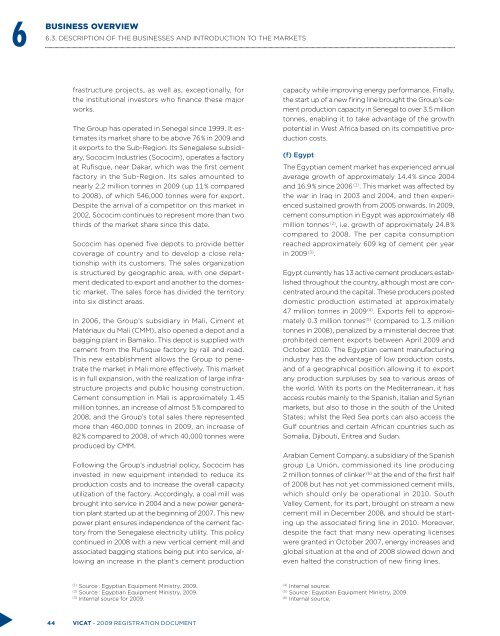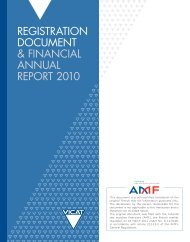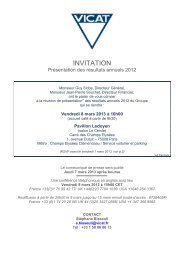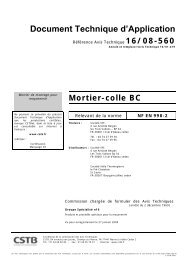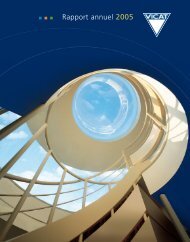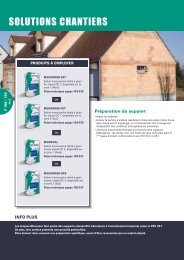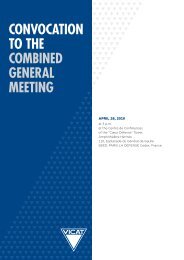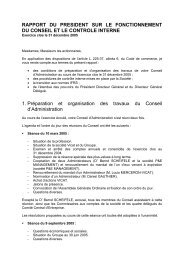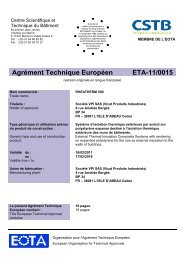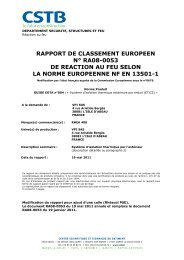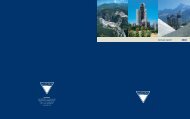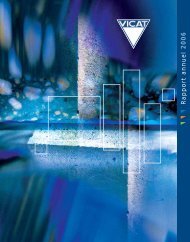6 - Vicat
6 - Vicat
6 - Vicat
- No tags were found...
Create successful ePaper yourself
Turn your PDF publications into a flip-book with our unique Google optimized e-Paper software.
6BUSINESS OVERVIEW6.3. DESCRIPTION OF THE BUSINESSES AND INTRODUCTION TO THE MARKETSfrastructure projects, as well as, exceptionally, forthe institutional investors who finance these majorworks.The Group has operated in Senegal since 1999. It estimatesits market share to be above 76 % in 2009 andit exports to the Sub-Region. Its Senegalese subsidiary,Sococim Industries (Sococim), operates a factoryat Rufisque, near Dakar, which was the first cementfactory in the Sub-Region. Its sales amounted tonearly 2.2 million tonnes in 2009 (up 11 % comparedto 2008), of which 546,000 tonnes were for export.Despite the arrival of a competitor on this market in2002, Sococim continues to represent more than twothirds of the market share since this date.Sococim has opened five depots to provide bettercoverage of country and to develop a close relationshipwith its customers. The sales organizationis structured by geographic area, with one departmentdedicated to export and another to the domesticmarket. The sales force has divided the territoryinto six distinct areas.In 2006, the Group’s subsidiary in Mali, Ciment etMatériaux du Mali (CMM), also opened a depot and abagging plant in Bamako. This depot is supplied withcement from the Rufisque factory by rail and road.This new establishment allows the Group to penetratethe market in Mali more effectively. This marketis in full expansion, with the realization of large infrastructureprojects and public housing construction.Cement consumption in Mali is approximately 1.45million tonnes, an increase of almost 5 % compared to2008, and the Group’s total sales there representedmore than 460,000 tonnes in 2009, an increase of82 % compared to 2008, of which 40,000 tonnes wereproduced by CMM.Following the Group’s industrial policy, Sococim hasinvested in new equipment intended to reduce itsproduction costs and to increase the overall capacityutilization of the factory. Accordingly, a coal mill wasbrought into service in 2004 and a new power generationplant started up at the beginning of 2007. This newpower plant ensures independence of the cement factoryfrom the Senegalese electricity utility. This policycontinued in 2008 with a new vertical cement mill andassociated bagging stations being put into service, allowingan increase in the plant’s cement productioncapacity while improving energy performance. Finally,the start up of a new firing line brought the Group’s cementproduction capacity in Senegal to over 3.5 milliontonnes, enabling it to take advantage of the growthpotential in West Africa based on its competitive productioncosts.(f) EgyptThe Egyptian cement market has experienced annualaverage growth of approximately 14.4 % since 2004and 16.9 % since 2006 (1) . This market was affected bythe war in Iraq in 2003 and 2004, and then experiencedsustained growth from 2005 onwards. In 2009,cement consumption in Egypt was approximately 48million tonnes (2) , i.e. growth of approximately 24.8 %compared to 2008. The per capita consumptionreached approximately 609 kg of cement per yearin 2009 (3) .Egypt currently has 13 active cement producers establishedthroughout the country, although most are concentratedaround the capital. These producers posteddomestic production estimated at approximately47 million tonnes in 2009(4). Exports fell to approximately0.3 million tonnes (5) (compared to 1.3 milliontonnes in 2008), penalized by a ministerial decree thatprohibited cement exports between April 2009 andOctober 2010. The Egyptian cement manufacturingindustry has the advantage of low production costs,and of a geographical position allowing it to exportany production surpluses by sea to various areas ofthe world. With its ports on the Mediterranean, it hasaccess routes mainly to the Spanish, Italian and Syrianmarkets, but also to those in the south of the UnitedStates ; whilst the Red Sea ports can also access theGulf countries and certain African countries such asSomalia, Djibouti, Eritrea and Sudan.Arabian Cement Company, a subsidiary of the Spanishgroup La Unión, commissioned its line producing2 million tonnes of clinker (6) at the end of the first halfof 2008 but has not yet commissioned cement mills,which should only be operational in 2010. SouthValley Cement, for its part, brought on stream a newcement mill in December 2008, and should be startingup the associated firing line in 2010. Moreover,despite the fact that many new operating licenseswere granted in October 2007, energy increases andglobal situation at the end of 2008 slowed down andeven halted the construction of new firing lines.(1)Source : Egyptian Equipment Ministry, 2009.(2)Source : Egyptian Equipment Ministry, 2009.(3)Internal source for 2009.(4)Internal source.(5)Source : Egyptian Equipment Ministry, 2009.(6)Internal source.44 VICAT - 2009 registration document


